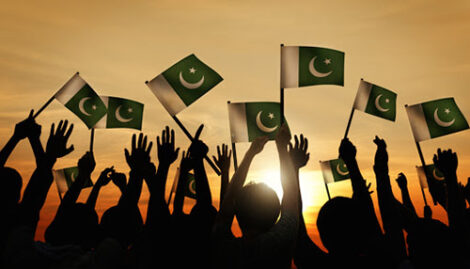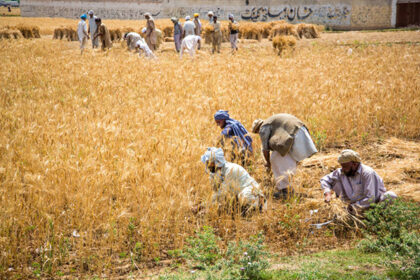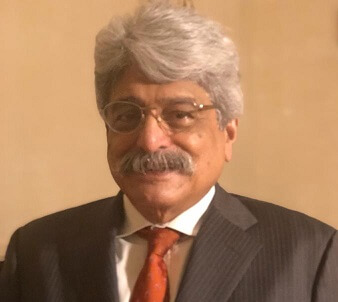The Pakistani nation has seen many trials and tribulations over the past few decades, emanating from forceful global trends unleashed by the fall of the Berlin Wall in November 1989 and the collapse of the Soviet Union in December 1991. A new world order came into existence with a sole superpower directing global political and economic affairs. Survival of the fittest and rules of globalisation drove national economic agendas. There was a race among competing nations to become victors in the contest of globalisation and avoid becoming its victims.
With trillions of dollars worth of financial and trade flows at stake, there was a scramble for economic reforms across the globe to capture national advantage in highly connected, innovative and competitive global markets driven by international rules of engagement. This opening up of global markets and competition enormously benefited countries that aggressively reformed themselves. In 1989, China had a per capita income of $310 per year whereas Pakistan had a per capita income of $384. Since then, reforms have grown Chinese per capita income 32 times to reach $10,000 per year and in comparison Pakistan’s efforts have only yielded a growth of 3.3 times to reach $1,300 per year. Clearly a failure of leadership is responsible for the substandard outcome for Pakistan.
In the challenging and rapidly changing global environment, further complicated by the 9/11 American War on Terror, strategically important Pakistan has always been in the eye of the storm, but failed miserably to carve out advantageous outcomes. Failure of leadership has been inter-temporal and multidimensional; its leadership failed to carry out meaningful economic reforms needed to compete in global markets and create the economic muscle needed for sustainable economic growth in spite of multiple IMF programmes and failed to reap economic advantage from being the most allied of allies of the Americans. It faced sanctions in spite of being the frontline state against the Soviet invasion of Afghanistan and playing a decisive and leading role in its subsequent defeat; it suffered the most in terms of both human life and material goods and was not fully compensated in the War on Terror, nor was it granted the preferential market access and investment flows it needed in spite of being a Major Non-NATO Military Ally of the USA.
Time and again, the Pakistani leadership was found wanting and not focused on nation building or reforms, instead it excelled in mastering money laundering techniques and corrupt practices; it displayed monumental incompetence in negotiating international contracts that have come home to haunt and impoverish the nation; collectively it has crashed the economy numerous times and sought dozens of unsuccessful trysts with the IMF, culminating in economic bankruptcy in 2018. The current, 22nd IMF programme is the toughest of all the programmes put together; the bitter medicines of upfront adjustments in exchange rates, interest rates and power rates, though long overdue, have exacted a huge price from the hapless citizenry in the shape of inflation, job losses and a substantial drop in purchasing power.
Coupled with the pandemic, Pakistan has gone through an extraordinarily tough time. Almost a year into the Programme, it seems the government of Prime Minister Imran Khan has turned the corner. It has successfully averted default, it has been able to sustain a market based exchange rate and succeeded in lowering interest rates, it has successfully weathered the inflationary onslaught and political blowback, it has deftly managed the Covid pandemic, boosted the export sector, jump-started construction activity, initiated low cost housing programmes and started development and regeneration of cities, created momentum in environmental protection, expanded the social security net, rejuvenated the accountability process and started civil service reforms. Exports are rebounding, remittances are increasing, reserves are building up and the business community has resumed investment, but there is still a long way to go.
The Prime Minister is determined to fulfil every commitment made with the people of Pakistan, to realise the ‘tryst with destiny’ that the founding fathers made in 1947. In today’s terms this ‘tryst with destiny’ means:
1. That the fifth largest populated country in the world should also have an equally large economy that performs to its best potential and provides the employment and prosperity that the people of Pakistan deserve.
2. That the Pakistani nation is enabled to excel in innovation, knowledge and creativity to propel the country forward.
3. That Pakistan becomes the logistics hub and lynchpin of the region.
4. That Pakistan’s large population becomes the base of the next ‘Factory of the World’ after China.
The Prime Minister knows that his greatest challenge is to ensure that as a nation we have a clear focus, vision and commitment to reach the promised destination and we continuously and persistently endeavour to succeed in creating a prosperous Pakistan much beyond the confines of the current IMF programme.
The macroeconomic framework is embedded in the IMF programme and various initiatives and action plans are being implemented to ensure that economic stabilisation is achieved and Pakistan does not enter into recurrent economic crises. The government is aware that stabilisation alone would only result in a low level equilibrium with low growth and employment expansion. To overcome the foreign debt overhang we would need to push the economy into a much higher orbit of sustainable output by enhancing productivity and competitiveness of the economy to compete in global markets.

The strategy has to be driven by domestic and foreign investment, overseas Pakistanis and their remittances, technology induction and exports. This requires that substantial investment climate reforms be made quickly to remove a plethora of investment hurdles that have been implanted in Pakistan over the years. The government of Prime Minister Imran Khan fully realises that sectorial investment strategies to boost the dynamics and productivity of the agriculture, industry and the services sectors can only be realised when the cost of doing business is substantially reduced and the ease of doing business is substantially increased. Boosting investor confidence is the number one priority of the Prime Minister and he is devoting enormous time and effort to reforming the bureaucratic and regulatory processes that impede investment.
There are many factors that affect the cost of doing business and the ease of doing business in Pakistan, however progress in two areas stands out as the most critical; high power rates make the cost of doing business exceedingly high, while the government regulatory system and an onerous tax system destroy the ease of doing business in Pakistan. The government is focused on reforming both and success will determine how quickly Pakistan’s economy can move into a robust cycle of high investment, employment and economic growth.
Investment strategies are largely dependent on creating opportunities for better and more efficient utilisation of national resources. In this context it is useful to view the national economy through a spatial lens as an intricate combination of a rural economy and an urban economy. The overall productivity, competitiveness and potential of the economy depend on both the urban and rural economy pulling their weight.

In this context, Pakistan’s rural economic endowment comprises 70 million acres of arable land, 200 Million Acre Feet (MAF) of fresh water annually and 60 percent of the population engaged in the rural economy. The rural economy output of around $60 billion or 22 percent of GDP is quite paltry. With 60 percent of the population producing 22 percent of output, rural poverty is endemic.
There is a colossal waste of water, land and human resources in the rural economy. Simple back of the envelope calculations show that if Pakistan’s water resource alone was available in a modern agricultural economy like Australia, it would produce an output of two billion dollars annually from every MAF of fresh water. With this yardstick, the rural economy of Pakistan alone has the potential of producing an output of 400 billion dollars or seven times its current level.
An overview of the rural economy reveals that its institutions and supply chains have become fossilised and dysfunctional over time, due to neglect and lack of investment. Furthermore, due to dwindling research and development efforts, poor seed quality and lack of seed multiplication and distribution networks, farmers have limited access to quality seed. Farm extension services are substandard and supply systems of critical inputs weak, with limited rural finance availability.
Rural markets are primitive and open to abuse of the farmer. Value added connectivity and farm to market infrastructure are weak. Linkages to global markets are inadequate. Cost of production is high and farm yields, productivity and incomes are rapidly declining. Government regulatory focus on food security has taken the wind out of a competitive rural economy. Both urban consumers and rural producers are the losers. Under the rural revitalisation strategy, the rural economy can readily absorb ideas and investments, particularly from overseas Pakistanis as well as global firms specialising in food product value chains.
In the Punjab, the Prime Minister has directed that twenty-five rural economy value chains encompassing food products, agricultural commodities, dairy and livestock, fruits and vegetables, horticulture, poultry, fisheries, and forestry etc., may be strategically revitalised and upgraded; the entire chain from Research & Development (R&D) to seed multiplication and breeding, to farm extension and farmer support systems, inputs and finance, and access to markets are to be reformed and revamped. The government will support programmes to facilitate private sector investment, quality and productivity enhancement, logistics and value addition, as well as creating brands for access to export and domestic markets.
The urban economy also presents great opportunities for investment and growth. The productivity of the urban economy is around three times higher than the rural economy. Furthermore, Pakistan is witnessing one of the highest urbanisation rates in the world, assisted by rural to urban migration. In the next three decades, over 70 percent of the population will live in the urban areas. An extremely youthful urban population, exceeding 200 million, inhabiting hundreds of large and small towns and cities stretching from the coastal regions of the Arabian seas to the gateway into China at the Khunjerab Pass is a huge economic resource. With labour costs in China, Europe and East Asia rising sharply, many labour intensive jobs are shifting to lower cost countries. Pakistan has a great opportunity to attract these jobs into Pakistan’s urban economy. Innovative Pakistani cities would become the home of many of these new jobs.
Like the rural economy, the urban economy also suffers from gross neglect and mismanagement. Urban value chains are mainly geared to cater to domestic demand and produce low quality products. The ratio of exports to GDP hovers around 10 percent and is insufficient to power the growth of the economy. While a few cities have developed as export centres, none of them can be considered globally competitive cities on par with those in East Asia or China. Poor industrial infrastructure with poor ecosystems for production and distribution make them uncompetitive.
An overpowering regulatory burden stifles growth, discourages scale production or innovation. The result is that very few Pakistani companies reach a global scale and prefer to stay small. On the positive side, each city has thousands of entrepreneurs who can be facilitated to form the backbone for upscaling and modernising existing value chains and creating space for new products and markets.
While the Prime Minister’s focus on two new cities — the Ravi Riverfront development and Karachi’s Bundle Island initiative — grabs the headlines, the urban strategy for Punjab involves all district headquarters. The overall strategy is to develop the infrastructure of the cities to provide water supply, sanitation, mobility, health and educational facilities to the urban areas, according to standards envisaged in sustainable development goals. While this is the traditional approach to cities, the Prime Minister has directed that each city not only have a Master Plan to manage its growth on environmentally sound principles, it must also have an economic development plan that spells out the economic opportunities that would be available to its citizens and create the infrastructure and knowledge system for the city’s value chains. Thus each city will have an ecosystem that provides a competitive advantage for its specific production specialisations and create globally competitive products.
In Punjab, the Rural Economic Strategy and the Urban Economic Strategy are being integrated at the divisional level. All nine divisions of Punjab are preparing an integrated strategy and plans that will integrate the rural and urban value chains into a development plan encompassing a cluster based ‘system of cities’ and rural hinterlands, that will plug the productivity and competitiveness gaps in the division. The divisional plans will seek out investment funds from public sector annual development plans as well as public-private partnerships, private enterprise capital, foreign investors, investment funds and overseas Pakistanis so that the investment gap is addressed and we can reap full benefits from the divisional opportunities inherent in natural and human resources.
In spite of the pandemic, the international environment for implementing the Prime Minister’s agenda is quite conducive. The exit of the Trump administration means that a multipolar world based on peaceful international economic cooperation and global trading rules will re-emerge. Peace may dawn in West Asia and the Middle East. The winding up of the American involvement in Afghanistan and Pakistan’s role in its orderly execution can lead to peace in Afghanistan. In this respect Pakistan’s request to the new US administration to join in the CPEC initiative and participate in economic partnerships with Pakistan and beyond into Central Asia and Western China has considerable economic logic.
Having eliminated domestic terrorism, Pakistan is now open for foreign business travel, its production systems are working full-time, it has an exceptional relationship with China and CPEC has moved to the second phase. A big jump is expected in trade and investment flows with China. Discussions on a free trade agreement with the US, offered by Senator Lindsay Graham during the Trump administration, can be reactivated. GSP Plus status is available with the EU. The economic and political relationship with Iran, Turkey and the Middle East can expand. The government of Prime Minister Imran Khan is focused on investment and growth. The domestic and international environment is helpful. The time is ripe to fulfil our tryst with destiny.

The writer is a former Finance Minister and founder of Bridge-Asia Financial Services. Currently, he serves as an advisor to the Chief Minister of Punjab on Economic Affairs and Planning & Development.



